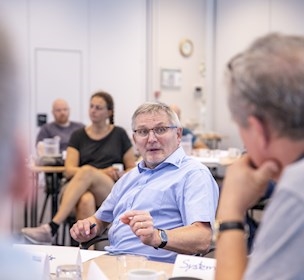Auditor course structures internal audits at Aarhus Airport
Challenge
Following the arrival of several new employees, Aarhus Airport lacked an overview and experience with internal audits.
Solution
Through an auditor course, the organisation acquired the necessary competencies and a shared foundation for conducting internal audits.
Result
Aarhus Airport now applies a structured approach and has a clear plan for conducting internal audits and developing an annual audit cycle.
Aarhus Airport has taken its first step towards a structured annual cycle for internal audits. An intensive auditor course prepared the organisation for the task.
Internal audits require more than good intentions
Established as a local airport in 1946, Aarhus Airport A/S has since evolved into an international airport, serving more than 500,000 passengers annually.
To meet requirements set by the Danish Civil Aviation and Railway Authority, Aarhus Airport needed to implement internal audits. However, the organisation lacked both a systematic approach and the necessary experience.
"We simply had not conducted the internal audits we are required to do. Now we are doing it properly and equipping everyone for the task," says Julie Søndergaard Poulsen, HR and Safety Manager at Aarhus Airport A/S.
The auditor course provided structure and confidence
The solution was to attend an auditor course, which turned out to be an eye-opener for Julie Søndergaard Poulsen. The course provided a complete overview of the process – from planning and execution to reporting and follow-up.
"I have gained a systematic approach to conducting internal audits. We now have templates and structures in place and are much better prepared," says Julie. "I now understand the full process and can focus on what we ourselves can improve," she elaborates.
The course combined theory with practical casework and exercises, catering to a range of learning styles.

Annual audit cycle and organisational ownership
After the course, Aarhus Airport initiated the annual audit cycle, assigned responsibilities and is now preparing to communicate the plan to the entire organisation.
"We now know who does what and when. The next step is to prepare staff so that audits are seen as support rather than control," Julie explains.
The path to becoming a lead auditor begins with the proper foundation
Shortly before the auditor course, Julie Søndergaard Poulsen had completed an introductory course in quality management and ISO 9001 at FORCE Technology. She recommends starting with the introductory course.
"It made the auditor course much easier to understand. I was even able to help others on the course because it was all fresh in my memory," she notes. Her next step is to attend FORCE Technology's lead auditor course.
"We now have the tools. The next goal is to ensure audits are of high quality and deliver credible results," concludes Julie Søndergaard Poulsen from Aarhus Airport A/S.




